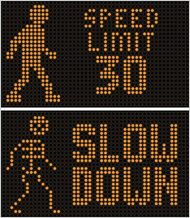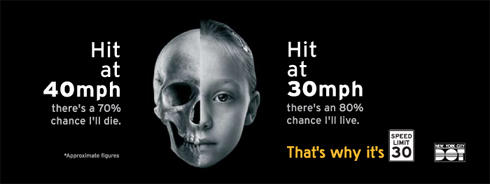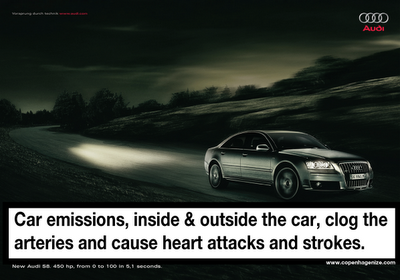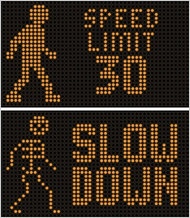 Photos: New York City Department of TransportationMaybe the flashing skeleton will get their attention.
Photos: New York City Department of TransportationMaybe the flashing skeleton will get their attention.
That’s what the New York City Department of Transportation is hoping, anyway. The city announced yesterday that it will start using electronic message boards saying “Speed Limit 30” and “Slow Down” with a skeleton figure in an attempt to get drivers to stop speeding.
The city has also unveiled a billboard with a half-skull, half-child’s face image to bring home the message that when someone is hit at 40 mph, there is a 70 percent chance they’ll be killed; at 30 mph, there’s an 80 percent chance they’ll live. There are some funny TV ads supporting the campaign as well, which play on a New Yorker’s stereotypical need to be know-it-alls.
 Other anti-speeding initiatives include a pilot 20 mph zone in a Bronx neighborhood and allocating more money to enforcement of speeding laws.
Other anti-speeding initiatives include a pilot 20 mph zone in a Bronx neighborhood and allocating more money to enforcement of speeding laws.
All this reminded me of an ad campaign proposed awhile back by Mikael Colville-Andersen of Copenhagenize, in which cars would be labeled like cigarettes — as the dangerous and often death-dealing consumer items that they are.
Shouldn’t we have rules dictating that all advertisements for automobiles must have clearly visible warning labels? There are a variety of smoking texts that can be applied to the car health warnings.
Car emissions cause emphysema / Driving causes cancer / Driving clogs your arteries / Don’t transport your children by car / Driving — A leading cause of death / Quitting will improve your health / Driving harms unborn babies / Driving is addictive / Car emissions are toxic /
 Illustration: CopenhagenizeSound unlikely? Sure. But so did banning smoking in bars, once upon a time.
Illustration: CopenhagenizeSound unlikely? Sure. But so did banning smoking in bars, once upon a time.
The willingness of a major city like New York to treat irresponsible automobile use as a public health issue, and to put serious PR resources into countering it (there was a previous campaign against engine idling as well) is a sign of some kind of shift (no matter what you think of their “Don’t be a jerk” bike campaign.)
Oh, and this is all coming at a time when car-related fatalities and injuries are at the lowest levels in a century in the city.
Is it time for a Vision Zero? That’s the revolutionary initiative undertaken in Sweden to reduce traffic fatalities to…zero. One of its precepts: “Human life and health are paramount and take priority over mobility and other objectives of the road traffic system.”
Could Americans ever look at the roads the same way? Or is getting there faster always going to be more important than human life?
And can ad campaigns make a difference?
I’d love to hear your thoughts in the comments.



